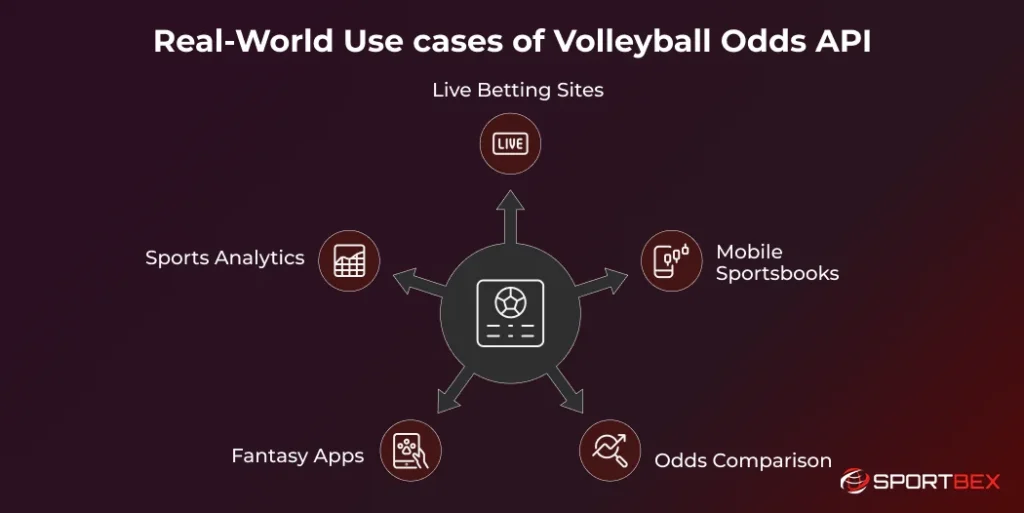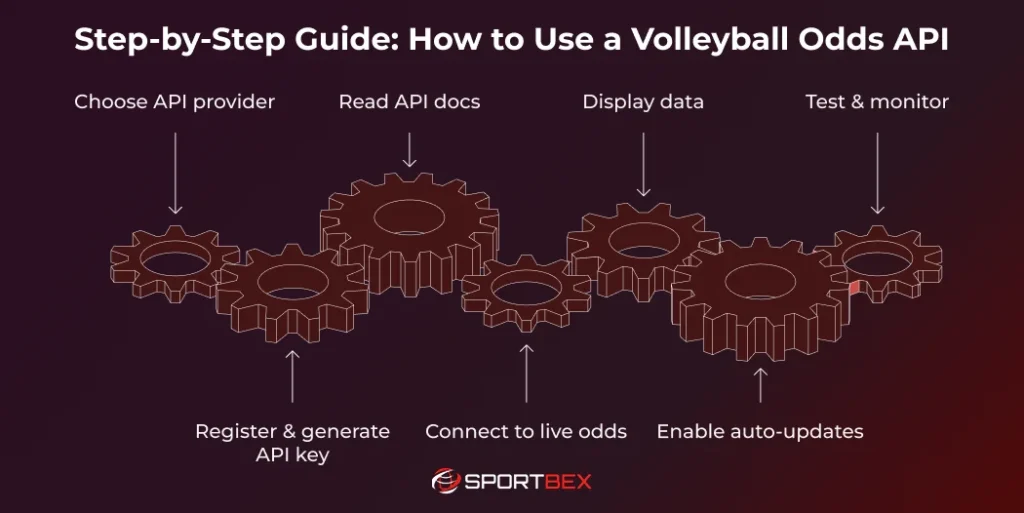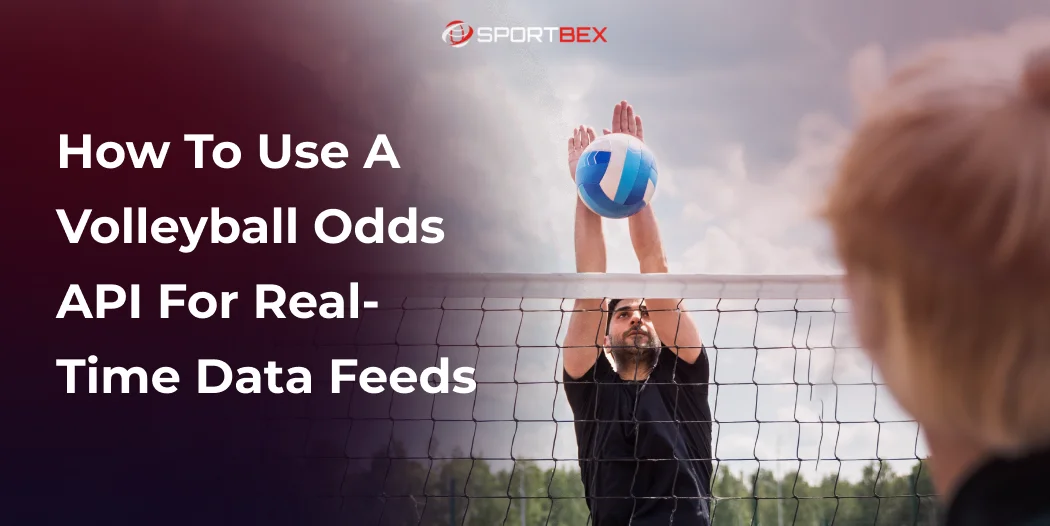Volleyball betting is booming! Fans are flocking to leagues, Olympics, and tournaments. From beach to indoor games, live betting is thriving. With a Volleyball API, Users get real-time alerts on odds changes, injuries, or momentum shifts during key sets.
A volleyball odds API can make your platform more engaging. Whether it’s a sportsbook, fantasy app, or odds site, real-time Volleyball data gives you a competitive edge. Learn how to use a Volleyball Odds API for real-time data feeds to improve your platform and stay ahead of competitors.
This guide shows you how to use a volleyball betting API with key features, examples, and step-by-step integration. By the end, you’ll be ready to create a volleyball data experience your users will love!
What Is a Volleyball Odds API?
A volleyball odds API gives you the latest betting info quickly and easily. Think of it as your personal sports reporter, keeping track of every match, odds, scores, and betting lines, and sending updates straight to you.
Here’s how it works: the API connects sports data providers to your app or platform. These providers gather data from sportsbooks, tournaments, and leagues worldwide. When something changes—like odds, scores, or betting options—the API updates instantly.
API volleyball tools go beyond odds and scores, offering player stats, team rankings, match records, injuries, and even weather for outdoor games. Some also track betting trends and market changes.
These APIs use advanced technology for fast, reliable updates. Cloud systems ensure smooth performance, while data validation prevents errors. A volleyball odds API keeps your betting platform accurate and up-to-date.
Why Use a Volleyball Odds API for Real-Time Data Feeds?
Using real-time volleyball data through an API can completely change your user experience and business results. Here’s why this technology is a must for modern sports platforms:
Real-time updates keep users engaged. Live match stats and changing odds create excitement and loyalty. Outdated data frustrates users and drives them to platforms with accurate live info. Up-to-date volleyball scores and stats help attract and retain users.
Real-time data unlocks big revenue opportunities. Live betting is booming, especially among volleyball fans. With a Volleyball data API, offering live odds during matches is seamless, unlocking new revenue streams unavailable with static data.
Accurate data is essential. Manual entry leads to errors, delays, and costly mistakes. A volleyball odds API automates data delivery, ensuring reliability. APIs also make scaling easier—use trusted providers and focus on great user experiences.
APIs save money. The monthly fee is far cheaper than collecting your volleyball data, and you get instant access to global data coverage that would take years to build.
Key Features to Look for in a Volleyball Odds API
Choosing the right API provider is crucial for your volleyball platform’s success. Here’s what to look for:
- Wide Coverage: Pick an API that includes international leagues, pro tournaments, the Olympics, college volleyball, and emerging leagues. More coverage means a better user experience.
- Fast Updates: Real-time data is key. The best APIs update within 1-3 seconds during live matches. Slow updates (like every 30 seconds) can frustrate users, especially during live games.
- Variety of Markets: A good API goes beyond basic options like match winners. Look for APIs with set scores, player stats, first team to score, and other specialized markets to keep users engaged.
- Access to Historical Data: APIs with detailed archives of past matches, stats, and odds trends let you create in-depth analysis, predictive features, and better user experiences.
- Reliability: Your platform needs a Reliable Volleyball API with at least 99.9% uptime and backup systems to avoid disruptions. Volleyball games won’t pause for tech issues, and neither will your users.
- Clear Documentation: Good documentation saves time and headaches. Look for APIs with step-by-step guides, examples, and detailed instructions for smooth integration.
With these features, you’ll ensure a great experience for your users and a reliable, engaging platform.
Real-World Use Cases of Volleyball Odds API

Volleyball data APIs are being used in amazing ways across sports technology! Let’s take a look at how different platforms are using this tech to create fun experiences for users and boost their revenue.
Live Betting Sites
Live betting platforms make volleyball more exciting by allowing fans to bet during matches. Odds constantly change based on the game. For instance, if a team is down 0-2 in sets, their comeback chances open new betting options.
Top live betting sites use volleyball APIs to offer quick, detailed bets during each set. Fans can bet on the next team to score, whether the set goes to extra points, or on player mistakes. These platforms depend on fast data updates, supported by reliable bookmaker data feeds, to ensure accurate and timely odds.
Covering Every Major Volleyball League
Get live scores and stats from the FIVB Nations League, SuperLega, and more.
Mobile Sportsbooks
Mobile apps need seamless API integration to meet user expectations. They want instant notifications for odds changes, live scores, and quick volleyball match betting. Top sportsbooks and volleyball betting apps use volleyball Live Score APIs to let users follow games and get alerts for their favorite teams or bets.
Real-time push notifications keep users engaged even when they’re not using the app. If a top volleyball team is losing, users get instant alerts about improved betting odds for a comeback.
Odds Comparison
Odds comparison sites are essential for sports betting, helping users find the best odds across sportsbooks. They track bookmakers to highlight differences. A volleyball odds API simplifies this by providing standardized data for quick comparisons.
The best platforms go beyond odds, offering charts to track changes, betting trends, and alerts for good deals. Users can even set notifications for when a team’s odds reach a specific level.
Fantasy apps
Fantasy sports apps are booming, fueled by stats and live updates. In fantasy volleyball, this means tracking player stats, injuries, lineup changes, and performance. A volleyball API tracks players in real time to help make smarter lineup decisions.
Advanced platforms offer daily fantasy contests for individual matches or tournaments, with real-time scoring that updates instantly as players earn stats.
Sports Analytics
Data analytics platforms benefit both casual volleyball fans and professional analysts. They offer insights on trends, team performance, and market activity with tools like predictions, performance tracking, and team comparisons.
For sports betting, analytics platforms help sportsbooks set better odds and find profitable opportunities. The quality of their analysis depends on having accurate, real-time data through reliable APIs.
Step-by-Step Guide: How to Use a Volleyball Odds API

Now for the fun part – here’s how to add a volleyball odds API to your platform! We’ll guide you step by step to make it simple and error-free, so your users get the real-time experience they’re looking for.
Step 1: Choose Your API Provider
Choosing the right API provider is key for your integration project. Start by listing your needs—geographic coverage, update frequency, data types, and budget. Some providers focus on pro leagues, while others specialize in college or amateur games.
The best way to test is during real volleyball matches and compare it to other sources. Check their customer support and technical documentation too. Good support saves time and headaches during setup, and a helpful team ensures smooth integration!
Step 2: Register & Generate API Key
After choosing a provider, create a developer account on their platform. Share basic details like your use case, expected traffic, and contact info. Pick a plan that suits your needs now but allows room to grow.
Once registered, access the developer dashboard to create and manage API keys. These keys act as your login and track usage. Most providers offer separate keys for testing and live environments, so you can develop without affecting real data or live limits.
Step 3: Read API Docs
Reading API documentation might not be exciting, but it can save you a lot of time during development. Good volleyball betting APIs, including those available on Rapid API, provide clear details about endpoints, parameters, response formats, and error codes.
Make sure to check the rate limits and usage rules. Most APIs limit how often you can send requests, and going over the limit could lead to temporary blocks or extra charges. Knowing this upfront helps you plan your system properly.
Step 4: Connect to Live Odds
The setup depends on your development tools, but most APIs use REST or WebSocket connections. For sports betting websites, REST works well for occasional updates, while WebSocket is ideal for real-time data, like live sports betting.
Test the connection to confirm authentication works and access basic volleyball match data. Start with simple endpoints like team info or past results before moving to live feeds. This step-by-step approach catches issues early.
Step 5: Display Data
To create a clear, user-friendly data display, focus on what users need and how they’ll view it. Volleyball odds can be complex, with many betting markets and changing values. Organize the key details clearly without overwhelming users.
Real-time data is only useful if users can quickly see what’s new. Think about how they access it—on desktops, tablets, or phones. Many volleyball fans check odds on the go, so make sure the display works on smaller screens without losing key details.
Step 6: Enable Automatic Updates
Automatic data refreshing keeps information accurate in real time, but it must be handled carefully to avoid slowing systems or frustrating users. WebSocket connections are ideal for live updates, sending instant notifications without repeated HTTP requests.
If you’re using REST API polling, adjust the refresh rate based on the context. Manage users with multiple tabs or app windows to ensure all updates are consistent without excessive API calls, keeping data smooth and consistent.
Step 7: Test & Monitor Performance
Thorough testing makes sure your integration works smoothly in all situations, like during high traffic, network issues, or unusual data changes. Create test cases that mimic real volleyball scenarios, such as long sets, player changes, or sudden odds shifts.
If you expect a lot of users during big volleyball tournaments, load testing is a must. Your API should perform well and stay accurate, even with hundreds or thousands of users checking live updates at the same time.
Conclusion
The volleyball betting and sports data world is evolving quickly, with real-time data platforms and volleyball data feeds leading the way. Setting up real-time data integration can be challenging, but the benefits—like providing instant, accurate volleyball info—are worth it.
Success with volleyball APIs comes from understanding user needs, using effective technology, and knowing how to integrate Volleyball APIs seamlessly. Whether it’s a betting site, fantasy platform, or pro tools, real-time data is key to engaging experiences.
Real-time API integration goes beyond providing scores and odds. It builds trust with accurate data, keeps users engaged with live updates, and opens new revenue opportunities. When users see instant updates during matches, they’re more likely to stay loyal to your platform, especially when offering the best volleyball betting odds.
To succeed with volleyball APIs, focus on solving real user problems. Understand your audience’s needs, choose reliable data providers, and design simple, user-friendly interfaces.
Build a Premier Platform for Volleyball Fans
Use our fast and reliable API to create an engaging and data-rich experience.
Frequently Asked Questions
A Volleyball Odds API is a tool that delivers live betting odds and match data directly to websites, apps, or betting platforms in real time.
Reliable providers like Sportbex offer highly accurate and real-time data with minimal latency, ensuring bettors get the latest odds instantly.
Yes, most APIs are mobile-friendly and can be integrated into both Android and iOS apps for live betting features.
Coverage depends on the provider, but top APIs usually include major leagues, international tournaments, and domestic matches.
With proper documentation and support, integration is straightforward and can be done by most developers within a short time.
Recent Blog
Top Benefits of Basketball Betting Odds for Betting Platform
December 12, 2025
 9 min
9 min
How to Use Greyhound Racing Data to Create Performance Insights
December 11, 2025
 9 min
9 min







